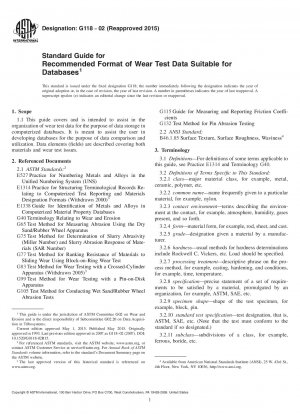ASTM G118-02(2015)
Standard Guide for Recommended Format of Wear Test Data Suitable for Databases
- Standard No.
- ASTM G118-02(2015)
- Release Date
- 2002
- Published By
- American Society for Testing and Materials (ASTM)
- Latest
- ASTM G118-02(2015)
- Scope
5.1 This guide can be used to facilitate categorizing wear data for insertion into a computerized database. This guide identifies a set of essential data fields which should be provided for all records, and also identifies additional optional data fields. This guide does not require the use of any particular database format, nor does it endorse any particular computer database software.
5.2 Because of increased activity in building computerized databases and the desire to encourage their uniformity and therefore the ease of data comparison and data interchange, it is appropriate to provide a guide for the inclusion of wear test data in databases. Availability of a guide also encourages the builders of databases to include sufficiently complete information so that comparisons among individual sources may be made with assurance that similarities or differences, or both, in the wear test procedures and conditions are covered.
5.3 The set of data fields described in this guide will usually be expanded and customized by the user for specific purposes. It should be possible to arrange the additional fields within the logical structure that is presented in this guide.
5.4 This guide does not apply to data from rolling contact wear tests, galling tests, or erosion or cavitation tests. Data that are included should apply to standard tests or to steady-state wear.
5.5 This guide has no implication on data required for materials production or purchase. Reporting of actual test results should be as described in the actual material specification or as agreed upon between the purchaser and the manufacturer, as shown on the purchase order and acknowledgement.
1.1 This guide covers and is intended to assist in the organization of wear test data for the purpose of data storage in computerized databases. It is meant to assist the user in developing databases for the purpose of data comparison and utilization. Data elements (fields) are described covering both materials and wear test issues.
ASTM G118-02(2015) Referenced Document
- ASTM E1314
- ASTM E1338 Guide for Identification of Metals and Alloys in Computerized Material Property Databases
- ASTM E527 Standard Practice for Numbering Metals and Alloys (UNS)
- ASTM G105 Standard Test Method for Conducting Wet Sand/Rubber Wheel Abrasion Tests
- ASTM G115 Standard Guide for Measuring and Reporting Friction Coefficients
- ASTM G132 Standard Test Method for Pin Abrasion Testing
- ASTM G40 Standard Terminology Relating to Wear and Erosion
- ASTM G65 Standard Test Method for Measuring Abrasion Using the Dry Sand/Rubber Wheel Apparatus
- ASTM G75 Standard Test Method for Determination of Slurry Abrasivity (Miller Number) and Slurry Abrasion Response of Materials (SAR Number)
- ASTM G77 Standard Test Method for Ranking Resistance of Materials to Sliding Wear Using Block-on-Ring Wear Test
- ASTM G83 Standard Test Method for Wear Testing with a Crossed-Cylinder Apparatus
- ASTM G99 Standard Test Method for Wear Testing with a Pin-on-Disk Apparatus
ASTM G118-02(2015) history
- 2002 ASTM G118-02(2015) Standard Guide for Recommended Format of Wear Test Data Suitable for Databases
- 2002 ASTM G118-02(2007) Standard Guide for Recommended Format of Wear Test Data Suitable for Databases
- 2002 ASTM G118-02 Standard Guide for Recommended Format of Wear Test Data Suitable for Databases
- 1996 ASTM G118-96 Standard Guide for Recommended Format of Wear Test Data Suitable for Databases
